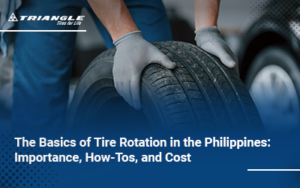Philippine roads can be unpredictable for drivers—one moment, the sun shines, and the next, you’re navigating heavy rain or unexpected flooding. Uneven roads and potholes only add to the challenge.
That’s why maintaining proper tire grip is essential not only for your wheels but also for everyone’s safety. Strong traction gives you better control, whether braking on wet pavement or driving over rough terrain.
The good news: enhancing tire grip is simple with a few adjustments and regular maintenance.
The Importance of Tire Grip
Tire grip is the friction between your tires and the road, allowing your car to stay stable when accelerating, braking, or turning. It helps you maintain control in various driving conditions. Proper tire pressure and selection are key to optimizing traction.
A good tire grip reduces the risk of hydroplaning on flooded roads during heavy rains. It also keeps you stable on rough, pothole-filled streets. Proper tire grip ensures shorter stopping distances and smoother handling, which is crucial on busy roads like EDSA.
Without it, you might have a more challenging time controlling your vehicle and increase the risk of accidents.
7 Ways to Improve Tire Traction
You don’t need expert skills to boost tire grip—simple maintenance and smart driving can make a big difference. Here are some practical tips to improve your car’s tire traction.
1. Choose tires designed for tropical climates
Not all tires are the same. In the Philippines, where roads can change from dry to wet in minutes, it’s best to use all-season tires for tropical conditions. These tires typically have deeper grooves and specialized rubber compounds that grip wet and dry surfaces better.
If you do some off-road driving, consider all-terrain tires. Their larger treads offer improved traction on both rough trails and smooth highways.
2. Maintain correct tire pressure
Underinflated tires have a larger surface area touching the road. It may seem like it increases grip, but it reduces control and increases rolling resistance. On the other hand, overinflated tires have less contact with the road and can cause poor traction.
Ideally, you check your tire pressure at least once weekly or every time you gas up. Keep it within the manufacturer’s recommended range, which you can find in your car manual or on the sticker inside the driver’s door.
Use a tire pressure gauge or refer to your car’s tire pressure monitoring system (TPMS) if it is available. Even a slight reduction in tire pressure can lead to underinflation and potential damage while driving.
3. Replace worn tires
Bald or heavily worn tires lose their grip on the road, especially when raining. It’s time to replace them if your tire tread depth is less than 1.6mm. To check, insert a one-peso coin into the tread with the “head” facing up. If the coin’s outer ring is visible, your tires are worn and may no longer provide adequate traction.
4. Clean tires regularly to remove mud and debris
Mud, dirt, and small rocks can get stuck in tire treads, reducing their ability to grip the road. So, make it a habit to clean your tires regularly, especially after driving through muddy or rough terrain. Rinsing with water and a brush can help remove debris and maintain proper traction.
5. Reduce speed on wet roads
Wet roads can be extremely slippery, and driving too fast increases the risk of hydroplaning. Remember to slow down to prevent water from damaging your tires.
Avoid sudden braking or sharp turns, as they can cause your car to skid. Instead, apply gentle, steady pressure on the brakes and maintain a safe following distance to stay in control on slippery roads.
6. Align and balance wheels
Misaligned or unbalanced wheels can reduce traction and increase wear, making your car harder to control. If your tires wear unevenly or your steering feels off, ask a professional to align and balance your wheels. These steps improve grip and extend your tires’ lifespan.
7. Inspect suspension and shocks for damage
Picture a bumpy road, and with every little pothole, your car bounces excessively. Not only does this make for an uncomfortable ride, but it also means your tires aren’t gripping the road as they should. Uneven tire wear, excessive bouncing, or a rough ride are signs that your suspension needs attention.
If you notice these issues, have your suspension system checked and repaired to ensure a safer, smoother drive.
Stay in Control, Rain or Shine
Prioritizing tire grip maintenance isn’t just smart—it’s essential. Good traction keeps you safe, improves handling, and gives you peace of mind whenever you get out on the road. Follow the tips above to enhance your car’s performance and stay in control all the time.
If you’re looking for quality tires, Triangle Tires has you covered. From passenger cars to heavy equipment, we offer reliable, affordable options delivered straight to you.
Browse through our products or contact us for your tire needs.


